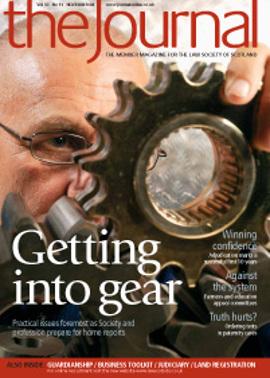Book reviews

Gaming in Pubs and Clubs: The New Law
In the first chapter of Gaming in Pubs and Clubs: The New Law, the author, Stephen McGowan, sets out his purpose – to provide the Scottish licensed trade and those who advise it with an “easy to understand guide to the new gambling law”. I think I can say, unequivocally, that he has achieved that purpose.
The guide is set out in a logical fashion, with a helpful and succinct introduction which sets the remainder of the guide in context. Mr McGowan covers all the topics you would expect – an overview of the regulatory system, particular types of gaming (in particular, machine gaming, equal chance gaming, lotteries, and bingo, to name but four), and enforcement and compliance. I found his explanation of the different types of machines in chapter 4 particularly helpful. It is all very well for the regulators to prescribe different categories, but how does a category D machine actually operate? For me it was useful to see specific examples of the types of machines within the different categories. Similarly the chapters on equal chance gaming and lotteries explain, briefly, the position under the old regime and then set out the rules in terms of the Gambling Act 2005, accompanied by some practical suggestions as to how these might work.
Although the guide is practical, for the “legal eagles” there are plenty of references to the relevant sections of the Gambling Act and accompanying regulations. These references are usually in the body of the text or in footnotes. The footnotes also contain references to articles and DCMS or Gambling Commission publications and guidance, all of which assist in understanding the legislation.
The appendices are also extremely helpful, the first listing, in alphabetical order, statutory references to definitions of relevant terms, for example “equal chance gaming” and “lottery”. The second gives details of numerous websites where those keen for more information can track down answers. The third lists, in chronological order, all the secondary legislation made to the date of publication.
If like me your heart sinks when telephoned by a client who expects a quick answer to the question “Can I have a race night in my pub?”, you need not worry: this book may well have the answer or at the very least it will point you in the right direction.
The Contract of Employment
Most solicitors practising in the area of employment law will have a range of texts on their library shelves dealing with the contract of employment. These will approach the subject principally, if not exclusively, from the perspective of English law. It is welcome, therefore, that Douglas Brodie, Professor of Employment Law at the University of Edinburgh, has produced a text devoted to the Scots law of the employment contract.
Prior to being asked to review this book for the Journal, a brief glance at the text had encouraged me to order copies for the firm’s library. A more detailed reading leads me to conclude that it is a text to which any employment lawyer practising in Scotland should refer when dealing with contract law.
There is a tendency to view employment law in Scotland as being the same as elsewhere in the UK. That is understandable given the UK statutory framework and the tribunal system which (with certain procedural differences) deals with disputes on a UK-wide basis. The Contract of Employment is a reminder that that view may not always be correct. It contains a comprehensive and valuable analysis of contract law in Scotland, identifying areas where Scots law may differ from English law.
At 275 pages, the text is concise, but it is dense in its content with a rich seam of information and authorities contained in the footnotes. It covers the full range of topics to be expected, including the formation, variation and termination of the contract. Detailed coverage is given to implied terms, including the duty of mutual trust and confidence (Professor Brodie is too modest to remind us how influential his view was in the House of Lords in Malik), the control of discretion, and the “work-wage bargain”. He also deals with areas such as misrepresentation where ordinarily an employment lawyer might reach for a text on general contract law.
Whilst the book is not written as a practical guide – there are no drafting tips and no style documents (and it is strangely refreshing for that) – it is nonetheless quite practical in its coverage of subjects like restrictive covenants. It also covers topics sometimes omitted from comparable English texts, such as the role of UCTA and judicial review.
The limited number of recent Scottish cases in some areas has allowed Professor Brodie to seek to resolve unanswered questions. He does so in a bold and reasoned way. Armed with the text, lawyers in Scotland may have more confidence in persuading the Scottish courts to pursue lines of authority which differ from the approach in England.
As an example, he considers material breach in some detail and the question of automatic versus elective termination of the contract. He argues strongly for the application of general principles in Scotland, recognising that the courts in England may be moving in a different direction. In other areas, which might typically be thought to be settled, he identifies the prospect for Scots law to be decided afresh. One example is the rights of an employee on sickness absence where the written terms of the contract are silent as to pay entitlements.
The chapter on damages is interesting. It is commonly held that the measure of damages in a wrongful dismissal claim is the amount that the employee would have earned during the notice period (subject to mitigation by the employee). Professor Brodie questions the underlying rationale for that limitation on damages. He also suggests that a Scottish court might show sympathy to a claim for solatium in a breach of contract claim. Were the Scottish courts to depart from the English position (fortified by Professor Brodie’s analysis), the consequences would be very significant. We might even see Scottish employers choosing English law to govern their contracts with senior employees.
In the short period since its publication, I have used this text regularly, if only to verify that the position in Scotland on a particular issue is the same as the position in England (which it must be said is often the case) and, in preparing for cases before the Scottish courts, to find, at a glance, Scottish cases for well known principles more commonly supported by English authorities.
In this issue
- Support where it's needed
- Prevention or cure?
- Gearing up for change
- A time for support
- Foreign companies and the Registers
- Sensitive relations
- New course for the courts
- Adjudication – 10 years on
- Jack's story
- Professional Practice Committee
- Sourcing our future
- Data security begins at home
- Going equipped
- Bonus round
- Nothing But Delivery
- Checking out checklists
- The final word
- Redundancy: an age old issue?
- Cohabitation update
- Inventive judging?
- Scottish Solicitors' Discipline Tribunal
- Website review
- Book reviews
- Beating the credit crunch
- Keeping a clean sheet
- Battening down in buy-to-let






